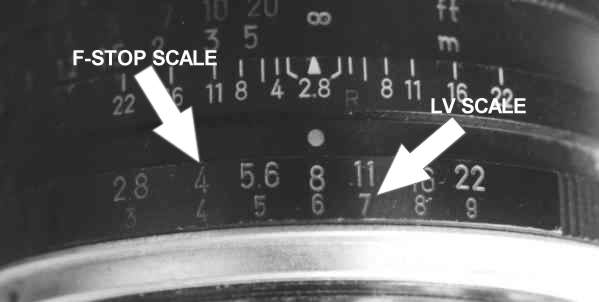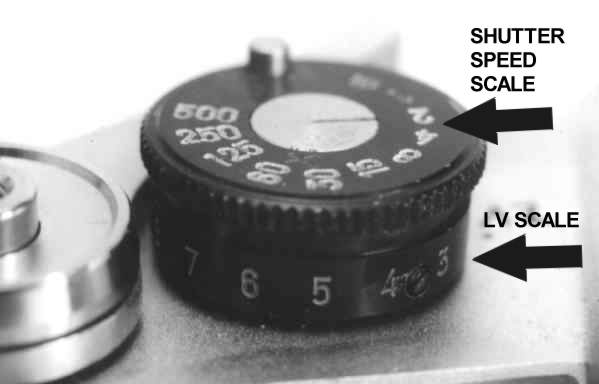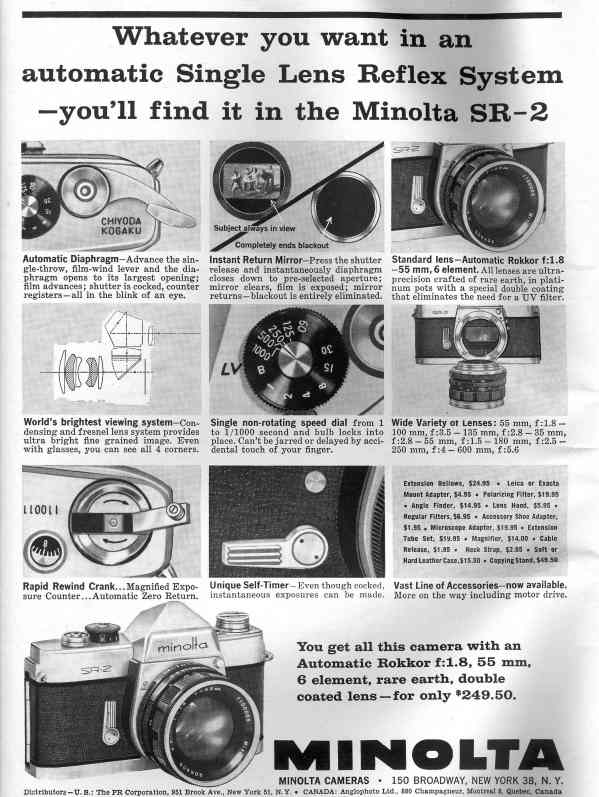

SR-2
The year was 1958. The Japanese camera industry was exploding with energy. Several companies had been marketing their new SLR cameras, such as the Asahiflex, Pentaflex, Miranda T, Topcon R and Zunow. These were selling quite well around the world despite having to compete with several German SLR cameras. At the time, Minolta was a recognized camera company, but they didn't make an SLR camera. Their sales were mainly in TLRs, Leica copies and 16mm subminiature cameras. The SR-2 was Minolta's first venture into the world of the SLR, and it was a giant gamble for them. Marketing an SLR -- a very expensive proposition -- would mean disaster for the company if it were a flop! Minolta understood this, and made an SLR that was a giant leap ahead for the company -- and for the marketability of the SLR camera in the world of photography. Sure, other companies offered SLR cameras with interchangeable lenses, but these cameras were rather clumsy to use. They lacked most of the convenience features that we take for granted today. For example, most SLR cameras of the time lacked an instant return mirror. After each picture, the mirror remained in the "up" position and the viewfinder was blacked-out until the film was advanced.
In addition, mechanically, lenses were much simpler and not coupled to the camera in any way. Today, we call these lenses, "manual lenses". Whenever the lens was stopped-down, the camera viewfinder got dark. Using small f-stops was a real challenge as the viewfinder quickly became useless. Manufacturers "solved" the problem in one of two ways -- each more awkward than the other. One approach, sometimes referred to as "semi-automatic", required the SLR photographer to cock the lens -- moving a lever on the side of the lens to set it at the largest f-stop -- after cocking the shutter on the camera. This kept the lens open to the maximum aperture until the picture was taken. A small lever in the camera released the lens just before the exposure was taken. But separately cocking the shutter and the lens was time-consuming and awkward. The other approach is referred to as "pre-set". These lenses have the standard aperture ring, but add a "pre-set" ring right next to it. On the aperture ring, you dial in the f-stop you want to use for the exposure, but leave the pre-set ring at full aperture. This set-up let's you compose and focus with the lens wide-open. Then, just before taking the picture, the pre-set ring is turned -- which stops the lens down. As with "semi-automatic" lenses, it's pretty awkward and prone to errors. First, fast, spontaneous pictures are impossible. And if you forget to turn the pre-set ring, the exposure is way off. Another problem with early SLR lenses was attaching and removing them from the camera. This was yet another, rather awkward, time-consuming process -- and best accomplished with three hands!
By 1958 Minolta had figured out how to make an easy-to-use SLR, and they hit the ground running. Other manufacturers had to scramble to keep up. It's no secret that the Minolta SR-2 completely changed SLR photography, and made it the wave of the future. That's why it's listed in the book, "The Evolution of the Japanese Camera" (published by the International Museum of Photography at George Eastman House in Rochester, New York) as one of the most important cameras in photographic history. The SR-2 made awkward lenses and blacked-out viewfinders things of the past. All of a sudden SLR cameras were actually fun to use instead of being too technically challenging for most people to master.
With the SR-2, the camera body offers automatic control of the lens diaphragm. This means that the lens remains at full aperture regardless of the f-stop selected -- and without the need to "cock" the lens. The camera stops-down the lens to the chosen f-stop automatically, at the instant of exposure, and the lens is "cocked" automatically when the film is advanced. It's no big deal today, but at the time it was a huge achievement. Actually, the diaphragm action on the SR-2 is best referred to as "semi-automatic". After an exposure, the aperture does not return to it's fully-open position. It is necessary to advance the film for the automatic diaphragm to become engaged. But since the camera lacks a depth-of-field button, this allowed you to check the depth-of-field before advancing the film. In addition, the SR-2 features an instant return mirror. It is no longer necessary to advance the film to see your subject at the maximum f-stop setting. For the first time, these features made using an SLR camera a much more pleasant experience, and pictures could be taken much more quickly.
Finally, the SR-2 had a new, easy to use, bayonet lens mount. Instead of the awkward, time-consuming screw-mounts and breech-mounts used by other manufacturers, the SR-2 offered a quick, three-pronged, bayonet mount. This mount is so simple that it is easy to use with a single hand, and only requires a quick, 54 degree turn to lock the lens in place. Pre-setting anything on the lens or the camera was no longer needed -- well, at least as long as you owned a Minolta! Changing lenses can be done in an instant, even in the dark, making spontaneous SLR photography a reality -- finally.
The SR-2 had a winning combination of features: an instant return mirror with semi-automatic lenses -- only the second Japanese camera to accomplish this feat. It had many other features and accessories as well, making the camera completely usable today.


When the SR-2 was introduced, Minolta needed to manufacture lenses that would
work with the new features of the camera -- and vice versa. These were
called the "Auto-Rokkor" lenses and had a pin on the
back of the lens that mated with a lever in the camera to keep the lens at
full-aperture -- until the moment of exposure. Initally when the SR-2
was introduced, there was only one Auto-Rokkor lens available -- the 55mm
f1.8 Auto Rokkor -- but the number quickly grew, and improvements were made
over time. In the end, there were actually two types of
Auto-Rokkor lenses. The early Auto-Rokkor lenses
were designed for the SR-2 and early SR-1 cameras that
had semi-automatic aperture function. But this changed when Minolta
introduced the SR-3 and SR-1 (model
c) which were designed for fully-automatic aperture operation. To
allow the latter cameras to instantly re-open the aperture in the lens after
the exposure (fully-automatic aperture operation), it was necessary for Minolta
to modify the aperture linkage in the original Auto-Rokkor
lenses. Specifically, the early Auto-Rokkor
lenses have their aperture linkage on a rotating, external plate
on the back of the lens.

This pin-and-plate approach proved inadequate to handle the speed of
a fully-automatic aperture, and Minolta modified the mechanism to an internal,
laterally-operating pin.
On the type 1 lenses, those with the rotating external plate, the aperture linkage moves vertically as it rotates on the plate. This requires a fairly tall lever inside the camera body, to make sure that the two will always engage as the plate in the lens rotates. The drawback is that the type 1 Auto-Rokkor lenses will not operate fully on later cameras. They were designed for cameras with smaller mirrors and the aperture pin, when used in the later cameras, bumps up against the mirror at higher apertures. While this may not cause damage to the mirror, it prevents many f-stops settings from being used. Several of the Auto-Rokkor lenses were made in both type 1 and type 2 styles.
The SR-2 was such a huge marketing success that Minolta was thrust from a modest camera company into the forefront of SLR photography. But Minolta did not rest on its laurels. The following year (1959) it produced a less expensive version of the SR-2 -- the SR-1 -- and just a year after that (1960) it replaced the SR-2 with the more advanced SR-3.
For a comparative look at the major features of the SR-2, check out
MINMAN's SLR table -- the world's most complete!
| Camera | Minolta SR-2 |
| Years made | 1958-1960 |
| Type | Mechanical 35mm SLR |
| Shutter | Fully mechanical, horizontal, cloth focal plane shutter |
| Metering | None |
| Meter sensitivity | -- |
| Exposure modes | Manual |
| Automatic exposure adjustment |
-- |
| Viewfinder | Fixed eye-level pentaprism |
| Focusing screen | Fresnel-field screen with a micro-prism center |
| Lens mount | Minolta SLR bayonet |
| Lenses | Optimum: early Auto Rokkor Usable: later Auto Rokkor, Rokkor, MC Rokkor, MC Rokkor-X, MC Celtic, MD Rokkor, MD Celtic, MD Minolta |
| Mirror | Instant return mirror |
| Film speeds | -- |
| Shutter speeds | Mechanical: 1 - 1,000; B Manual: 1 - 1,000; B |
| Flash synch | X: B; 1 - 1/60 FP: B; 1 - 1/15 M: B; 1 - 1/15 MF: B; 1 - 1/15 |
| Flash connection | Clip-on, cold shoe X and FP PC contacts |
| Film counter | Automatically resetting type counting upward |
| Battery | -- |
| DOF/Stop-down button | No |
| Film Back | Non-interchangeable |
| Multiple exposures | No |
| Film advance | Lever type |
| Self-timer | Mechanical, overrideable, non-cancellable, adjustable from 4 to 10 seconds |
| Film reminder | No |
| Other | Cable release connection, tripod socket |
| Body size | 2 x 3 1/2 x 5 3/4 inches |
| Body weight | One pound two ounces |

RETURN TO THE MANUAL MINOLTA HOME PAGE
We didin't want to do this, but since other websites have been stealing our
stuff, we have no alternative but to state:
COPYRIGHT@1995-2023 by
Joe McGloin.
All Rights Reserved. The material on this website is protected by US Federal
copyright laws. It cannot be copied or used in any manner without specific
approval from the owner.
The material on this website is protected by US Federal copyright laws. It cannot be copied or used in any manner without specific approval from the owner.